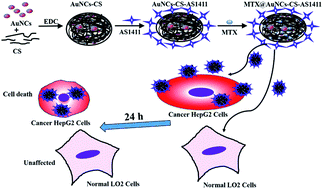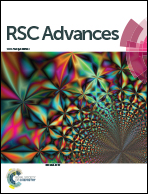A dual-functional nanovehicle with fluorescent tracking and its targeted killing effects on hepatocellular carcinoma cells
Abstract
All-in-one drug delivery nanovehicles with low cytotoxicity, high clinical imaging tracking capability, and targeted- and controlled-releasing performances are regarded as promising nanoplatforms for tumor theranostics. Recently, the design of these novel nanovehicles by low molecular weight amphiphilic chitosan (CS) was proposed. Based on fluorescent gold nanoclusters (AuNCs), a tumor-targeting nanovehicle (i.e. AuNCs-CS–AS1411) was prepared via electrostatic attraction between AuNC-conjugated chitosan (i.e. AuNCs-CS) and the anti-nucleolin aptamer, AS1411. After that, the anticancer drug methotrexate (MTX) was encapsulated into the nanovehicles and then the dual-functional nano-drug (i.e. MTX@AuNCs-CS–AS1411) was comparatively supplied to the human hepatocellular carcinoma cell line HepG2 and the human normal liver cell line LO2, to exhibit its “all in one” behavior. Under the conditions of the same concentration of MTX, MTX@AuNCs-CS–AS1411 demonstrates more intensive cytotoxicity and apoptosis-inducing activity against HepG2 cells than those against normal LO2 cells, mainly due to the targeting effect of AS1411 on the nucleolins that were found at high levels on the surface of tumor cells, but are at low levels or absent on normal cells. On the other hand, the MTX release from the MTX@AuNCs-CS–AS1411 was much faster in mildly acidic solution than that in neutral pH. Thus, it may provide a possibility to more significantly release MTX in intracellular lysosome of tumor cells, rather than let loose MTX during transport of the drug from blood vessels to tumor tissue. In conclusion, our dual-functional nanovehicle possesses high fluorescence efficiency and photostability, low cytotoxicity, pH-dependent controlled release, high sensitivity and target-specificity to cancer cells which allowed concurrent targeted imaging and delivery in cancer chemotherapies.



 Please wait while we load your content...
Please wait while we load your content...